2. 中国海洋大学海洋与大气学院,山东 青岛 266100;
3. 阿尔弗雷德·魏格纳极地与海洋研究所,不来梅哈芬 德国 27570;
4. 中国海洋大学未来海洋学院,山东 青岛 266100
1896年,瑞典科学家斯万特·阿伦尼乌斯(Svante Arrhenius)指出大气中二氧化碳浓度的变化可以改变地表温度的变化,而在高纬度地区,表层温度变化更为明显[1]。这种现象后来被称为“极地放大”[2]。近百年来,在温室气体辐射强迫的持续增加的作用下,全球气候持续变暖,而北极气候出现了非常明显的快速变暖现象(见图 1),北极升温在冬季最为明显(见图 2),其中,自卫星观测开始以来,北极区域的平均表面温度上升速度是全球平均表面温度上升速度的2倍[3-4]、2~3倍[5-6]甚至是4倍[7]。这种在相同的外部辐射强迫增加的作用下,北极相对于全球的快速变暖现象被称为“北极放大”[8-9]。代用指标重建的古气候数据[10]、历史观测数据[11]和气候模型模拟数据[12]均揭示了“北极放大”效应的存在。
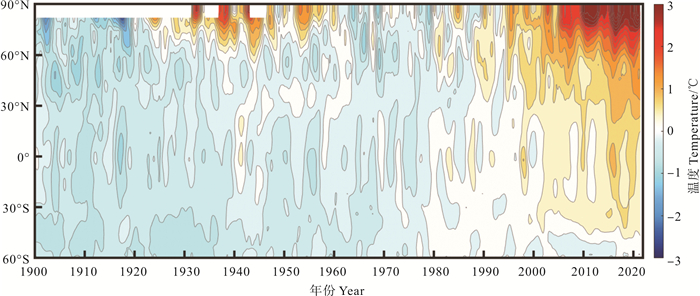
|
( 基于GISTEMP v4数据[13],气候态为1961—1990年。Based on GISTEMP v4 Data[13]. The reference period is the 1961—1990 climatology. ) 图 1 1900—2022年全球纬向平均表面温度异常(单位:℃) Fig. 1 Global zonal mean surface temperature anomalies (unit: ℃) from 1900 to 2022 |
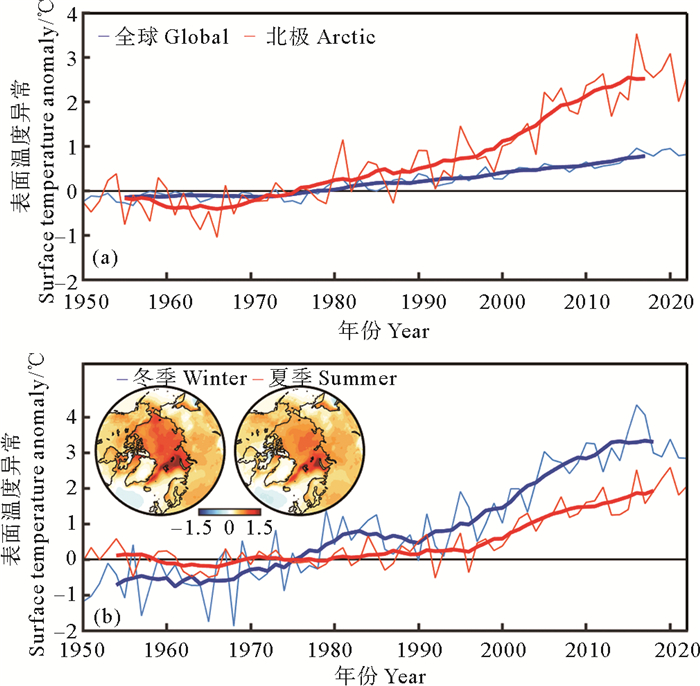
|
( 基于ERA5(the fifth generation ECMWF reanalysis)数据[14]。北极冬季:11月—次年3月,夏季:6月—10月,气候态为1961—1990年。粗线代表 11年滑动平均值。Based on ERA5 (the fifth generation ECMWF reanalysis) data[14]. The reference period is the 1961—1990 climatology. The Arctic winter is defined as the period from November to March of the following year and summer is defined as the period from June to October. The thick lines indicate the 11-year moving average. ) 图 2 (a) 1950—2022年全球和北极表面温度异常(单位:℃)及(b)1950—2022年北极冬季与夏季表面温度异常(单位:℃)和表面温度趋势分布图(单位:℃/10 a) Fig. 2 (a) Global and Arctic surface temperature anomalies from 1950 to 2022 (unit: ℃) from 1950 to 2022 and (b) Arctic winter and summer surface temperature anomalies (unit: ℃) and surface temperature trends (unit: ℃/10 a) from 1950 to 2022 |
北极快速变化对局地与全球气候都有着显著的影响。北极变暖导致北极冰冻圈主要要素(包括积雪、多年冻土和海冰等)与生态系统发生显著变化[15-18],改变北极原有的碳储存与源汇格局,从而通过反馈机制影响全球气候系统[19]。此外,北极海冰与陆地冰雪的融化不仅通过淡水输出影响北大西洋深层水的形成,调节向深层海洋的热输送[20],进而对全球海洋环流与气候变化产生影响;同时,这些变化还通过影响区域能量收支平衡和大尺度大气环流,影响中纬度天气过程[21-22]。因此,理解北极快速变化的机制是深入认识北极与全球气候变化关系的重要科学问题。
气候系统中能够放大或抑制气候系统对外部扰动的响应的过程被称为反馈过程,包括大气、海洋、海冰、冰盖以及陆地表面之间的辐射或者非辐射因素[23]。在中低纬度区域,净反馈因子主要表现为负反馈特性[24],即在初始强迫扰动下,气候系统会通过内部的动力机制(包括大气、海洋自身的动力过程以及两者之间的相互作用)逐步地消耗外部扰动所带来的影响,使得气候系统朝着初始平衡状态的方向发展。但是,在高纬度地区,净反馈因子整体上表现为正反馈,这预示着一旦触发正反馈循环,可能导致气候系统的显著变化乃至“失控”效应[25]。
在局地层面,表面反照率[26-28]、大气温度递减率[29]、普朗克、云[30]和水汽[31-32]等反馈过程对北极放大都有贡献。除辐射反馈过程之外,海洋与大气的向极热输送亦对北极放大效应的形成也具有重要影响[33-36]。基于观测数据和气候模式,基本可以确定各种辐射反馈和非辐射反馈对北极放大的相对贡献[29, 37]。
但是,上述这些过程仍然存在较多的不确定性。例如,反照率反馈的核心是冰雪融化后导致表面反照率降低,海洋吸收更多的太阳辐射,这一过程主要发生在夏季。但是,如图 2(b)所示,北极放大的主要特征发生在冬、春季节[38]。研究指出这种季节滞后效应主要是因为海洋吸收和释放热量的滞后性导致,需要在确定反照率反馈作用时考虑这种滞后关系[39]。另外,云反馈包括通过云的反照率效应反射太阳短波辐射的负反馈作用,也包括通过云增温效应对长波辐射吸收、再辐射的正反馈作用。对于北极云反馈的模拟,不同模型之间的差异非常显著[40]。这些差异主要源于对云的各种参数(如云量、云高和云光学厚度等)的模拟存在不确定性[41],以及模型在处理地表-大气相互作用、云的微物理过程等方面的局限性[42]。
观测数据显示北极表面温度的变化呈现多年代际振荡[43],其振荡过程中变暖和变冷的速度都超过同期的全球平均,说明了北极局地正反馈在多年代际振荡过程的暖位相和冷位相中都起到了放大作用。但是,这些正反馈过程无法解释北极从变暖(变冷)转为变冷(变暖)的位相转换机制。因此,明确北极快速变化的物理机制,还需要确定导致北极温度多年代际振荡的驱动机制。
本文将在简要分析影响北极放大的反馈过程的基础上,着重分析这些反馈过程的不确定性及其对气候模式模拟预测北极海冰变化的影响,并分析关于气候系统多年代际变异及其与北极快速变化多年代际振荡之间的联系。
1 北极放大的驱动机制导致北极放大的局地反馈过程包括表面反照率反馈、普朗克反馈、大气递减率反馈、云和水汽反馈等[29, 38, 44]。
表面反照率反馈:图 3显示近年来北极海冰范围快速减小,海冰的融化会造成表面反照率反馈的变化,这是由于海冰与积雪相比于海水、陆地表面等具有更高的反照率,可反射90%以上的太阳短波辐射,并且阻隔海气和陆气之间的热量、动量与水汽交换。因此,冰雪融化会直接导致海洋或陆地表面吸收更多的太阳短波辐射而升温,而由于海水巨大的热含量,变暖的海水会反过来加剧海冰的进一步融化,从而形成相互加强的正反馈过程。
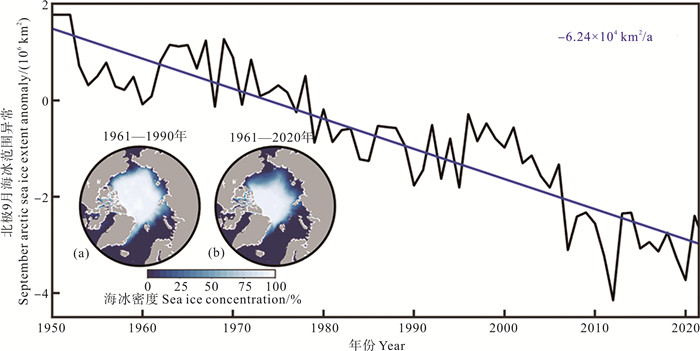
|
( 基于HadISST(Hadley Centre Sea Ice and Sea Surface Temperature data set)海冰数据[45],气候态为1961—1990年。黑色线代表北极九月海冰范围异常,蓝色线代表变化趋势。Based on HadISST sea ice data[45]. The reference period is the 1961—1990 climatology. The black line represents the September Arctic sea ice extent anomaly, while the blue line indicates thelinear trend. ) 图 3 1950—2022年北极9月海冰范围异常(单位:106 km2)和1961—1990年(a)及1991—2020年(b)海冰密集度平均值(单位:%) Fig. 3 September Arctic sea ice extent anomaly (unit: 106 km2) from 1950 to 2022 and the average sea ice concentration (units: %) for the periods 1961—1990 (a) and 1991—2020 (b) |
普朗克反馈:根据普朗克黑体辐射定律R=εσT4,其中R为地表发射的长波辐射;ε为发射率;σ为斯忒藩-玻尔兹曼常数,地表释放的能量随温度的升高而迅速增加。因此,当地表温度升高时,地球向外发射的长波辐射也会增加,从而抑制地球系统温度的进一步上升,这一过程有助于维持地球能量平衡的稳定性。极地地区相对于中低纬度地区绝对温度偏低,因此在同等辐射强迫作用下,极地区域需要更多的增温(以便于产生更多的向外长波辐射)来实现新的能量平衡[29]。
大气递减率反馈:温度垂直递减率指气温随海拔高度的增加而降低的速率。在热带地区,气温会随海拔高度的增加而降低,较重的冷空气向下运动,通过垂向对流耦合将地球表面和上对流层温度联系在一起。因此在净热辐射强迫作用下,对流层中高层的升温幅度明显高于低层,这种垂直增温结构有利于增加向外长波辐射,减小大气层顶的辐射强迫。相比之下,北极地区近地面存在温度随高度增加而增加的逆温层,使得表面冷而重的空气难以与上层较轻的空气混合。在北极,由于大气层级比较稳定,变暖主要被限制在低层。因此,在热带地区,垂直递减率反馈表现为负反馈,而在北极,则是正反馈[29]。
云反馈:云过程不仅通过影响可见光和红外波段的辐射通量影响地球气候系统的热收支平衡,还通过云反馈机制对气候变暖产生影响。云反馈包括通过云的反照率效应反射太阳短波辐射的负反馈作用,也包括通过云增温效应对长波辐射吸收、再辐射的正反馈作用。因此,大气层顶云的净效应为负反馈作用,而在地表则发挥正反馈作用。因此,云反馈在气候模型中的表现仍然是最大的不确定性来源之一[40]。
水汽反馈:水汽是地球系统中最强的温室气体。随着地表变暖,大气中的水汽含量也会增加,这些额外的水汽会吸收更多的长波辐射并导致进一步变暖。在背景温度较高且水汽增加最多的热带地区,这种水汽反馈最大[24]。水汽对北极能量预算的影响是多方面的,被称为水汽三重效应[44]:在水汽凝结之前,其存在本身就会增强温室效应;当水汽凝结形成云时,云量的增加会进一步影响北极的气候;这在北极冬季会产生变暖效应。
除了上述与表面辐射过程密切相关的反馈过程,极向热输送亦对北极放大效应的形成具有重要影响[35, 46]。大气向极热输送的变化分为干静态能量输送和水汽输送。随着全球气候的变暖,进入北极地区的干静态能量输送呈现减少趋势,而水汽输送则有所增加。增强的水汽输送不仅直接加强了北极地区的温室效应,还可能通过增加云量来进一步放大这一效应[47]。另外,观测研究和气候模型预测在全球变暖的背景下,海洋向极热输送将进一步增强[34, 48],进而驱动了北极变暖[35]。但是有研究显示,大气和海洋极向热输送的变化对北极温度变化的贡献要远小于表面反照率等反馈过程[29]。
气候系统内的各个反馈过程随纬度的变化[24]如图 4所示。整体而言,在地球气候系统中,低纬和高纬地区反馈过程的影响有所不同:在中、低纬度区域,气候系统反馈过程为负反馈为主,水汽正反馈无法抵消其他强烈的负反馈过程的影响。而在高纬度区域,不仅存在较强的反照率正反馈过程,而且垂直递减率反馈等过程都作为正反馈过程存在,正反馈过程主导着北极的气候变化,使北极气候系统在相同的辐射强迫作用下呈现加速变暖的放大特征,所以可将北极放大的驱动机制归因为北极气候系统的诸多正反馈过程。其中,由于北极放大是将北极与全球的平均温度变化相对比,所以尽管普朗克反馈在任何纬度都是负反馈过程,但其在两极地区的负反馈作用要远小于低纬度地区,因此,普朗克反馈也对北极放大有一定贡献。
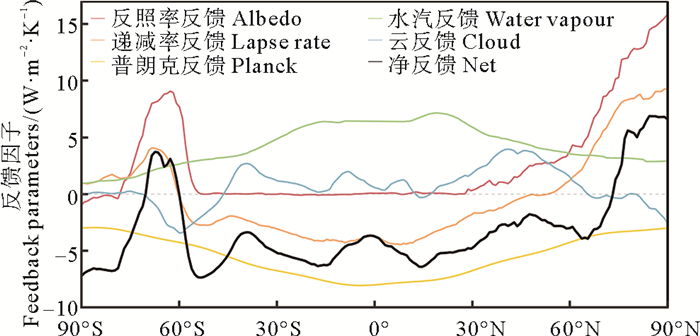
|
( 数据来源为地球系统模式大样本集合数值模拟项目所提供的全球气候模拟数据[49]。The data is derived from Community Earth System Model (CESM) large ensemble project[49]. ) 图 4 全球反馈因子(单位:W·m-2·K-1)纬向平均分布图 Fig. 4 Global zonal mean of feedback parameters (unit: W·m-2·K-1) |
上述反馈机制并不能完全地解释北极气候快速变化的现象。
2.1 表面反照率反馈对北极放大的作用大量证据表明[27],在全球气候变暖的背景下,表面反照率反馈及其与海冰和积雪相关的其他反馈机制是北极放大的主导因素。然而,气候模式的敏感性实验却显示,表面反照率反馈的作用很可能被高估。Graversen和Wang[50]利用CCSM3气候模式,设计了两组实验对比分析了表面反照率变化对北极放大的影响。在控制实验和敏感性实验中,气候系统都受到2倍大气CO2辐射强迫;与控制实验不同,敏感性实验的表面反照率在整个积分过程保持固定。通过对比两组实验结果,他们发现在模式中关闭表面反照率反馈时,北极温度仍然会以较快的速度升高,且两个实验中北极放大效应的差异不超过15%。这一敏感性实验说明反照率反馈并没有在北极快速变暖过程中占据主导地位,而云和水汽的变化在高纬度地区的温度升高中显得更重要。但是,为什么传统气候模式与敏感性实验会出现这种贡献作用的偏差,目前尚无具体的研究结果。
2.2 可能缺失的正反馈过程CMIP系列的气候模式包含所有上述的反馈过程,并且气候模式给出的反馈过程对北极放大的贡献大小差别不大,排序也基本一致[29]。但是,气候模式模拟预测的北极夏季海冰的融化速度仍然低于实际观测。从CMIP3[51]、CMIP5[52]到CMIP6[53]的实验都呈现这种显著的不足,导致这一问题可能有两个原因:一个是上述各种反馈过程的作用和贡献仍然存在较大的不确定性,需要通过观测和物理机制分析进一步确定各个反馈过程的影响;另一个原因是我们对影响北极海冰和海洋变化关键物理过程认识的缺失,模式中可能缺少一些实际存在的正反馈过程。
春季融池变化是其中一个典型的例子。Schröder等[54]分析发现模式中9月份北极海冰密集度的变化与春季表面融池的分布高度相关。春季海冰表面积雪融化会形成融池,而融池的出现会使得反照率下降超过20%。Schröder等[54]指出如果在气候模式中增加春季融池分布(大约每十年增加4%),会导致模式中7—8月的表面反照率下降(大约每十年降低3%),提升9月份北极海冰的预测能力。影响春季海冰表面融池形成的物理过程相对复杂,包括季节性的太阳短波辐射的增强,低纬度的极向热输送等因素,也包括极端天气过程导致海冰断裂形成冰间水道后,从海洋中释放的大量热量对局部天气和表层积雪的影响[55]。目前的气候模式还不能分辨和模拟这些极端和小尺度过程及其气候效应。
2.3 北极气候系统的多年代际振荡——北极快速变化的位相转换北极的平均表面温度、海洋温度和海冰外缘线都存在显著的多年代际振荡特征[43, 56-57]。如图 5所示,1920—1940年间,北极表面温度出现快速变暖的现象,其变暖速率大约是全球平均表面温度变暖速率的1~2倍;而从1940—1970年间,北极和全球气候都出现变冷的趋势,其中北极变冷的速度也是全球平均变冷速度的2~3倍[58]。这些现象说明北极和全球气候的多年代际变化之间存在紧密联系,并且在多年代际振荡的变暖和变冷两个位相期间,北极气候都存在放大特征。上述正反馈过程能够解释当气候系统进入变暖或者变冷位相后,其变暖或变冷速度被放大并超过全球平均变化速度的特性,但是无法解释北极气候从变暖(变冷)转为变冷(变暖)的位相转换过程。
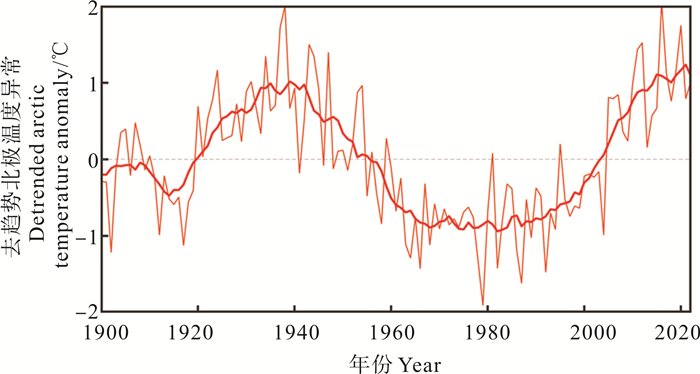
|
( 基于GISTEMP v4数据[13],基准期为1961—1990年气候态平均值。细线代表年平均异常值,粗线代表 11年滑动平均值。Based on GISTEMP v4 data[13]; The reference period is the 1961—1990 climatology. The thin line represents annual mean anomalies, while the thick line indicates the 11-year moving average. ) 图 5 1900—2022年去除线性趋势后的北极平均表面温度异常时间序列(单位:℃) Fig. 5 The linear detrended Arctic mean surface temperature anomalies (units: ℃) from 1900 to 2022 |
由于观测数据的长度限制,我们很难给出比较准确的北极气候的多年代际变化与全球平均表面温度的多年代际变化之间的位相关系。但是,从有近800年的北欧海海冰外缘线位置观测数据与北大西洋海表面温度的观测之间的关系[59]来看,北大西洋向北的热输运是控制北极海冰外缘线的主要因素。另外,Polyakov等[60-61]汇集了北冰洋海洋的历史温度观测数据,发现整个北冰洋中层海洋都呈现多年代际振荡的特性,并且从大西洋一侧到太平洋扇区,多年代际振荡的幅度逐步减弱。一些模式结果也显示北大西洋入流可以驱动北极气候具有与大西洋多年代际振荡相同的变率[62]。但是在此过程中,北极中层海洋的热输送与北极表面温度变化所呈现的多年代际振荡之间的动力学联系、大西洋的大气与海洋的极向热输送作用及其与北极局地正反馈过程之间的联系仍不明确。确定北极气候系统多年代际振荡的形成机制以及主要的气候反馈过程在其中的作用,是预测北极未来气候变化的关键挑战之一。
3 结语本文简要总结了影响北极放大的驱动机制,并指出表面反照率反馈等局地正反馈过程尚不足以全面解释观测到的北极快速变暖和变冷的过程和特征。核心的问题有两个:一是即使气候模式已经包含了上述所有正反馈过程,其预测的北极海冰融化速度仍然低于实际观测,这说明对上述正反馈过程影响作用的估计不准确,或者还存在一些尚未明确的正反馈过程;二是正反馈过程无法解释北极气候出现变暖和变冷的位相转换,需要探索驱动北极气候快速变化的位相转换机制。
上述两个问题存在一定的矛盾特性,问题一需要探索更多的正反馈过程,问题二需要寻找可能的负反馈机制,或者是北极气候系统之外的外部驱动力,两者叠加要求新的物理机制的认识既能够提高预测未来北极海冰融化速度的能力, 又要能够适时地驱动北极气候变化在多年代际时间尺度上的位相转换。这是提升未来北极以及全球气候变化预测能力的主要挑战之一。
| [1] |
Arrhenius S. On the influence of carbonic acid in the air upon the temperature of the Earth[J]. Publications of the Astronomical Society of the Pacific, 1897, 9(54): 14-24. (  0) 0) |
| [2] |
Manabe S, Stouffer R J. Sensitivity of a global climate model to an increase of CO2 concentration in the atmosphere[J]. Journal of Geophysical Research: Oceans, 1980, 85(C10): 5529-5554. DOI:10.1029/JC085iC10p05529 (  0) 0) |
| [3] |
Walsh J E. Intensified warming of the Arctic: causes and impacts on middle latitudes[J]. Global and Planetary Change, 2014, 117: 52-63. DOI:10.1016/j.gloplacha.2014.03.003 (  0) 0) |
| [4] |
Yu L, Zhong S, Vihma T, et al. Attribution of late summer early autumn Arctic sea ice decline in recent decades[J]. npj Climate and Atmospheric Science, 2021, 4(1): 1-14. DOI:10.1038/s41612-020-00158-3 (  0) 0) |
| [5] |
Jansen E, Christensen J H, Dokken T, et al. Past perspectives on the present era of abrupt Arctic climate change[J]. Nature Climate Change, 2020, 10(8): 714-721. DOI:10.1038/s41558-020-0860-7 (  0) 0) |
| [6] |
Richter-Menge J, Druckenmiller M L, Andersen J K, et al. State of the climate in 2019: The Arctic[J]. Bulletin of the American Meteorological Society, 2020, 101(8): S239-S286. DOI:10.1175/BAMS-D-20-0086.1 (  0) 0) |
| [7] |
Rantanen M, Karpechko A Y, Lipponen A, et al. The Arctic has warmed nearly four times faster than the globe since 1979[J]. Communications Earth & Environment, 2022, 3(1): 1-10. (  0) 0) |
| [8] |
Serreze M C, Francis J A. The Arctic amplification debate[J]. Climatic Change, 2006, 76(3): 241-264. (  0) 0) |
| [9] |
England M R, Eisenman I, Lutsko N J, et al. The recent emergence of Arctic amplification[J]. Geophysical Research Letters, 2021, 48(15): e2021GL094086. DOI:10.1029/2021GL094086 (  0) 0) |
| [10] |
Park H S, Kim S J, Stewart A L, et al. Mid-Holocene Northern Hemisphere warming driven by Arctic amplification[J]. Science Advances, 2019, 5(12): eaax8203. DOI:10.1126/sciadv.aax8203 (  0) 0) |
| [11] |
Bekryaev R V, Polyakov I V, Alexeev V A. Role of polar amplification in long-term surface air temperature variations and modern Arctic warming[J]. Journal of Climate, 2010, 23: 3888-3906. DOI:10.1175/2010JCLI3297.1 (  0) 0) |
| [12] |
Holland M M, Bitz C M. Polar amplification of climate change in coupled models[J]. Climate Dynamics, 2003, 21(3): 221-232. (  0) 0) |
| [13] |
Lenssen N, Schmidt G, Hansen J, et al. Improvements in the GISTEMP uncertainty model[J]. Journal of Geophysical Research: Atmospheres, 2019, 124(12): 6307-6326. DOI:10.1029/2018JD029522 (  0) 0) |
| [14] |
Hersbach H, Bell B, Berrisford P, et al. The ERA5 global reanalysis[J]. Quarterly Journal of the Royal Meteorological Society, 2020, 146(730): 1999-2049. DOI:10.1002/qj.3803 (  0) 0) |
| [15] |
Park H, Yabuki H, Ohata T. Analysis of satellite and model datasets for variability and trends in Arctic snow extent and depth, 1948—2006[J]. Polar Science, 2012, 6(1): 23-37. DOI:10.1016/j.polar.2011.11.002 (  0) 0) |
| [16] |
Biskaborn B K, Smith S L, Noetzli J, et al. Permafrost is warming at a global scale[J]. Nature Communications, 2019, 10(1): 264. DOI:10.1038/s41467-018-08240-4 (  0) 0) |
| [17] |
Serreze M C, Holland M M, Stroeve J. Perspectives on the Arctic's shrinking sea-ice cover[J]. Science, 2007, 315(5818): 1533-1536. DOI:10.1126/science.1139426 (  0) 0) |
| [18] |
Lannuzel D, Tedesco L, van Leeuwe M, et al. The future of Arctic sea-ice biogeochemistry and ice-associated ecosystems[J]. Nature Climate Change, 2020, 10(11): 983-992. DOI:10.1038/s41558-020-00940-4 (  0) 0) |
| [19] |
Nielsen D M, Chegini F, Maerz J, et al. Reduced Arctic Ocean CO2 uptake due to coastal permafrost erosion[J]. Nature Climate Change, 2024, 14: 968-975. DOI:10.1038/s41558-024-02074-3 (  0) 0) |
| [20] |
Chen X, Tung K K. Global surface warming enhanced by weak Atlantic overturning circulation[J]. Nature, 2018, 559(7714): 387-391. DOI:10.1038/s41586-018-0320-y (  0) 0) |
| [21] |
Cohen J, Screen J A, Furtado J C, et al. Recent Arctic amplification and extreme mid-latitude weather[J]. Nature Geoscience, 2014, 7(9): 627-637. DOI:10.1038/ngeo2234 (  0) 0) |
| [22] |
Wu B. Recent progresses in the study of the Arctic-midlatitude connection and its association with Arctic sea ice loss[J]. Chinese Journal of Atmospheric Sciences, 2023, 48(1): 108-120. (  0) 0) |
| [23] |
Hansen J, Lacis A, Rind D, et al. Climate Sensitivity: Analysis of Feedback Mechanisms[M]. American: Climate Processes and Climate Sensitivity, American Geophysical Union (AGU), 1984: 130-163.
(  0) 0) |
| [24] |
Armour K C, Bitz C M, Roe G H. Time-varying climate sensitivity from regional feedbacks[J]. Journal of Climate, 2013, 26: 4518-4534. DOI:10.1175/JCLI-D-12-00544.1 (  0) 0) |
| [25] |
Oldfield J D. Mikhail Budyko's (1920—2001) contributions to global climate science: From heat balances to climate change and global ecology[J]. WIREs Climate Change, 2016, 7(5): 682-692. DOI:10.1002/wcc.412 (  0) 0) |
| [26] |
Jenkins M, Dai A. The impact of sea-ice loss on Arctic climate feedbacks and their role for Arctic amplification[J]. Geophysical Research Letters, 2021, 48(15): e2021GL094599. DOI:10.1029/2021GL094599 (  0) 0) |
| [27] |
Screen J A, Simmonds I. The central role of diminishing sea ice in recent Arctic temperature amplification[J]. Nature, 2010, 464(7293): 1334-1337. DOI:10.1038/nature09051 (  0) 0) |
| [28] |
Thackeray C W, Hall A. An emergent constraint on future Arctic sea-ice albedo feedback[J]. Nature Climate Change, 2019, 9(12): 972-978. DOI:10.1038/s41558-019-0619-1 (  0) 0) |
| [29] |
Pithan F, Mauritsen T. Arctic amplification dominated by temperature feedbacks in contemporary climate models[J]. Nature Geoscience, 2014, 7(3): 181-184. DOI:10.1038/ngeo2071 (  0) 0) |
| [30] |
Taylor P C, Cai M, Hu A, et al. A decomposition of feedback contributions to polar warming amplification[J]. Journal of Climate, 2013, 26: 7023-7043. DOI:10.1175/JCLI-D-12-00696.1 (  0) 0) |
| [31] |
Kapsch M L, Graversen R G, Tjernström M. Springtime atmospheric energy transport and the control of Arctic summer sea-ice extent[J]. Nature Climate Change, 2013, 3(8): 744-748. DOI:10.1038/nclimate1884 (  0) 0) |
| [32] |
Vázquez M, Nieto R, Drumond A, et al. Extreme sea ice loss over the Arctic: An analysis based on anomalous moisture transport[J]. Atmosphere, 2017, 8(2): 32. DOI:10.3390/atmos8020032 (  0) 0) |
| [33] |
Lu J, Cai M. Quantifying contributions to polar warming amplification in an idealized coupled general circulation model[J]. Climate Dynamics, 2010, 34(5): 669-687. DOI:10.1007/s00382-009-0673-x (  0) 0) |
| [34] |
Spielhagen R F, Werner K, Sørensen S A, et al. Enhanced modern heat transfer to the Arctic by warm Atlantic water[J]. Science, 2011, 331(6016): 450-453. DOI:10.1126/science.1197397 (  0) 0) |
| [35] |
Hwang Y T, Frierson D M W, Kay J E. Coupling between Arctic feedbacks and changes in poleward energy transport[J]. Geophysical Research Letters, 2011, 38(17): L17704. (  0) 0) |
| [36] |
Huang Y, Xia Y, Tan X. On the pattern of CO2 radiative forcing and poleward energy transport[J]. Journal of Geophysical Research: Atmospheres, 2017, 122(20): 10, 578-10, 593. (  0) 0) |
| [37] |
Goosse H, Kay J E, Armour K C, et al. Quantifying climate feedbacks in polar regions[J]. Nature Communications, 2018, 9(1): 1919. DOI:10.1038/s41467-018-04173-0 (  0) 0) |
| [38] |
Previdi M, Smith K L, Polvani L M. Arctic amplification of climate change: A review of underlying mechanisms[J]. Environmental Research Letters, 2021, 16(9): 093003. DOI:10.1088/1748-9326/ac1c29 (  0) 0) |
| [39] |
Kim K Y, Hamlington B D, Na H, et al. Mechanism of seasonal Arctic sea ice evolution and Arctic amplification[J]. The Cryosphere, 2016, 10(5): 2191-2202. DOI:10.5194/tc-10-2191-2016 (  0) 0) |
| [40] |
Vial J, Dufresne J L, Bony S. On the interpretation of inter-model spread in CMIP5 climate sensitivity estimates[J]. Climate Dynamics, 2013, 41(11): 3339-3362. (  0) 0) |
| [41] |
Morrison A L, Kay J E, Frey W R, et al. Cloud response to Arctic sea ice loss and implications for future feedback in the CESM1 climate model[J]. Journal of Geophysical Research: Atmospheres, 2019, 124(2): 1003-1020. DOI:10.1029/2018JD029142 (  0) 0) |
| [42] |
Curry J A, Schramm J L, Rossow W B, et al. Overview of Arctic cloud and radiation characteristics[J]. Journal of Climate, 1996, 9(8): 1731-1764. DOI:10.1175/1520-0442(1996)009<1731:OOACAR>2.0.CO;2 (  0) 0) |
| [43] |
England M R. Are multi-decadal fluctuations in Arctic and Antarctic surface temperatures a forced response to anthropogenic emissions or part of internal climate variability?[J]. Geophysical Research Letters, 2021, 48(6): e2020GL090631. DOI:10.1029/2020GL090631 (  0) 0) |
| [44] |
Taylor P C, Langen P L, Tan I. Editorial: Arctic amplification: Feedback process interactions and contributions[J]. Frontiers in Earth Science, 2023, 11: 1140871. DOI:10.3389/feart.2023.1140871 (  0) 0) |
| [45] |
Rayner N A, Parker D E, Horton E B, et al. Global analyses of sea surface temperature, sea ice, and night marine air temperature since the late nineteenth century[J]. Journal of Geophysical Research: Atmospheres, 2003, 108(D14): 4407. (  0) 0) |
| [46] |
Graversen R G, Burtu M. Arctic amplification enhanced by latent energy transport of atmospheric planetary waves[J]. Quarterly Journal of the Royal Meteorological Society, 2016, 142(698): 2046-2054. DOI:10.1002/qj.2802 (  0) 0) |
| [47] |
Cai M. Dynamical amplification of polar warming[J]. Geophysical Research Letters, 2005, 32(22): L22710. (  0) 0) |
| [48] |
Bitz C M, Gent P R, Woodgate R A, et al. The influence of sea ice on ocean heat uptake in response to increasing CO2[J]. Journal of Climate, 2006, 19: 2437-2450. (  0) 0) |
| [49] |
Kay J, Deser C, Phillips A, et al. The Community Earth System Model (CESM) large ensemble project: A community resource for studying climate change in the presence of internal climate variability[J]. Bulletin of the American Meteorological Society, 2015, 96(8): 1333-1349. (  0) 0) |
| [50] |
Graversen R G, Wang M. Polar amplification in a coupled climate model with locked albedo[J]. Climate Dynamics, 2009, 33(5): 629-643. (  0) 0) |
| [51] |
Notz D, Community S. Arctic sea ice in CMIP6[J]. Geophysical Research Letters, 2020, 47(10): e2019GL086749. (  0) 0) |
| [52] |
Stroeve J C, Kattsov V, Barrett A, et al. Trends in Arctic sea ice extent from CMIP5, CMIP3 and observations[J]. Geophysical Research Letters, 2012, 39: 16502. (  0) 0) |
| [53] |
Shu Q, Wang Q, Song Z, et al. Assessment of sea ice extent in CMIP6 with comparison to observations and CMIP5[J]. Geophysical Research Letters, 2020, 47(9): e2020GL087965. (  0) 0) |
| [54] |
Schröder D, Feltham D L, Flocco D, et al. September Arctic sea-ice minimum predicted by spring melt-pond fraction[J]. Nature Climate Change, 2014, 4(5): 353-357. (  0) 0) |
| [55] |
Flocco D, Schroeder D, Feltham D L, et al. Impact of melt ponds on Arctic sea ice simulations from 1990 to 2007[J]. Journal of Geophysical Research: Oceans, 2012, 117: C09032. (  0) 0) |
| [56] |
Polyakov I V, Alekseev G V, Bekryaev R V, et al. Observationally based assessment of polar amplification of global warming[J]. Geophysical Research Letters, 2002, 29(18): 1878. (  0) 0) |
| [57] |
Zhang R. Mechanisms for low-frequency variability of summer Arctic sea ice extent[J]. Proceedings of the National Academy of Sciences, 2015, 112(15): 4570-4575. (  0) 0) |
| [58] |
Bokuchava D D, Semenov V A. Mechanisms of theearly 20th century warming in the Arctic[J]. Earth-Science Reviews, 2021, 222: 103820. (  0) 0) |
| [59] |
Divine D V, Dick C. Historical variability of sea ice edge position in the Nordic Seas[J]. Journal of Geophysical Research: Oceans, 2006, 111: C01001. (  0) 0) |
| [60] |
Polyakov I V, Alekseev G V, Bekryaev R V, et al. Long-term ice variability in Arctic marginal seas[J]. Journal of Climate, 2003, 16(12): 2078-2085. (  0) 0) |
| [61] |
Polyakov I V, Alekseev G V, Timokhov L A, et al. Variability of the intermediate Atlantic water of the Arctic Ocean over the last 100 years[J]. Journal of Climate, 2004, 17(23): 4485-4497. (  0) 0) |
| [62] |
Jungclaus J H, Haak H, Latif M, et al. Arctic-North Atlantic interactions and multidecadal variability of the meridional overturning circulation[J]. Journal of Climate, 2005, 18: 4013-4031. (  0) 0) |
2. College of Oceanic and Atmospheric Sciences, Ocean University of China, Qingdao 266100, China;
3. Alfred Wegener Institute Helmholtz Center for Polar and Marine Research, Bremerhaven 27570, Germany;
4. Academy of the Future Ocean, Ocean University of China, Qingdao 266100, China
 2024, Vol. 54
2024, Vol. 54

